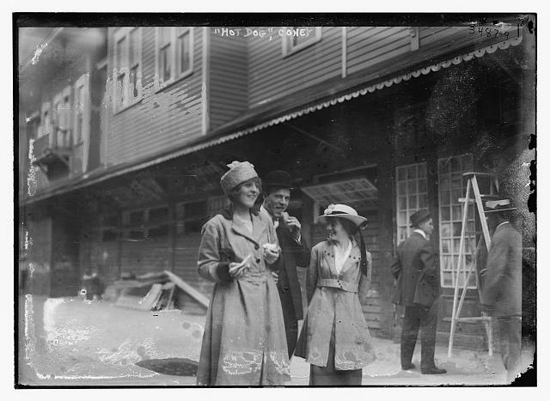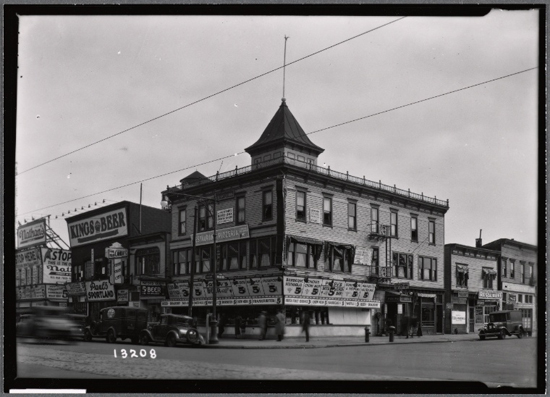The Stunt that Launched Nathan’s Famous Stand on Coney Island
Back in 1916, the now-famous Nathan’s hot-dogs of New York City did not sell on name alone
Nathan Handwerker ran a nickel hot dog business at the corner of Stillwell and Surf that became as much a part of Coney Island as Dreamland, Steeplechase and the Wonder Wheel. In the summer of 1916, according to one of the more apocryphal tales about the workingman’s lunch, Nathan’s held the first in what would become its annual Fourth of July hot-dog eating contest, a competition that pitted four immigrants against each other. The winner scarfed the most hot dogs as a demonstration of his American-ness. The contest still endures but it wasn’t the stand’s only stunt that brought in hungry visitors, nor was it the most convincing.
Handwerker, a Polish immigrant, got his start in New York as a dishwasher at Max’s Busy Bee. On weekends, he moonlighted at Feltman’s in Coney Island, an ocean pavilion home to Tyrolean singers, Swiss wrestlers, carousels and, according to one writer, its hideous noise. (The owner of the place, Charles Feltman, may have, in 1867 or 1874, commissioned a wheelwright to make him a wagon with a burner unit, thereby inventing the practice of serving sausages plonked inside a sliced “milk” bun, although Feltman railed against these mobile vendors in 1886, telling the Brooklyn Eagle, “Sausages must go.”) “A swank place, Feltman’s charged 10 cents for its hot dogs,” The New York Times wrote in 1966. “Jimmy Durante and Eddie Cantor, then singing waiters at Coney Island, complained that a dime was a lot of money for a frankfurter.”
So, in 1916, Nathan opened his eponymous hot dog stand and sold frankfurters for five cents each. The crowds, he later recalled, were initially stand-offish and a cut-rate frank remained a suspect food. This was 1916, remember, only a couple decades after the birth of the term “hot dog” and inexpensive meat came with questions. “Hot” was code for dodgy, and, as Barry Popnik, the co-author of a 300- page book called Origin of the Term “Hot Dog” writes, the phrase probably originated a kind of joke. Take, for instance, this popular 1860 song:
Oh! Where, oh! Where ish mine little dog gone?
Oh! where, oh! Where can he be?
His ear’s cut short, and his tail cut long:
Oh! Where, oh! where ish he?Tra, la la….
Und sausage is goot: Baloney, of course,
Oh! where, oh! where can he be?
Dey makes ‘em mit dog, und dey makes ‘em mit horse:
I guess dey makes ‘em mit he.
Customers in Coney Island had good reason to suspect Nathan’s original five-cent dogs would be of lower quality, maybe even the sign of an unscrupulous horse- or dog-killer—taboos that would become more un-American as the 20th century progressed. The Times had also reported that the “rottenest of all” the offal from New York’s hotel ended up in Coney Island’s frankfurters. “So Mr. Handwerker hired whie-jacketed young men to stand in front of his stand munching hot dogs. This brought in the ‘class’ visitors. They had decided that Nathan’s franks ‘must really be good because all the doctors are eating them.’”
The stunt with the “doctored” hot dogs apparently worked, immortalized as recipes for success in books like Selling: Powerful New Strategies for Sales Success. Medical marketing claims still sells food (“nitrate-free” hot dogs, anyone?), although the American carnival in Coney Island only, on rare occasion, includes any scientific, made-for-TV gastrointestinal scrutiny.
Moreover, the early gimmicks proved to be neither the first nor the last on the boardwalk. In 1954, Handwerker went to Miami Beach and left his son, Murray, in charge of the store. A man named Leif Saegaard approached him with a proposal to include a 75-foot long, 70-ton embalmed finback whale. Soon, Nathan’s Famous had a cetecean display, but thanks to an unexpected heat wave, the whale soon became a stench and was towed out to sea.
And with that, dear readers, I take my leave. This post concludes my time as a twice-weekly contributor to Food and Think. Follow me on Twitter or go to my website, where the show will go on.
Photos: “‘Hot Dog’ Coney” (date unknown)/Bain News Service/Library of Congress ; “ (1934)”/New York Public Library

